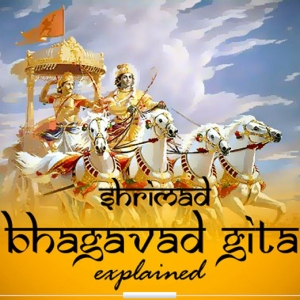1. Guidance in Life’s Complexities: The Bhagavad Gita addresses universal themes and dilemmas that individuals encounter in their daily lives. It provides valuable guidance on how to navigate the complexities of existence, make ethical choices, and find meaning in one’s actions.
2. Understanding of Duty (Dharma): The Gita emphasizes the importance of fulfilling one’s duty (dharma) with dedication and integrity. Reading it helps individuals gain clarity about their own roles and responsibilities in life, whether as a student, parent, worker, or citizen.
3. Path to Inner Peace: The teachings of the Gita offer a roadmap to inner peace and equanimity. By learning to act selflessly and without attachment to outcomes, readers can cultivate a sense of serenity and contentment even in the face of adversity.
4. Spiritual Enlightenment: For those on a spiritual quest, the Bhagavad Gita introduces various paths to spiritual realization, such as karma yoga (the path of selfless action), bhakti yoga (the path of devotion), jnana yoga (the path of knowledge), and dhyana yoga (the path of meditation). Readers can explore these paths and choose the one that resonates with them.
5. Overcoming Fear and Attachment: The Gita teaches the importance of recognizing the eternal self (atman) and detaching from the transient material world. This knowledge helps individuals overcome fear, attachment, and the cycle of birth and death.
Benefits of Reading the Shrimad Bhagavad Gita
1. Moral and Ethical Foundation: The Bhagavad Gita instills a strong moral and ethical foundation, promoting virtues such as honesty, compassion, and integrity.
2. Improved Decision-Making: The Gita’s teachings provide valuable insights into decision-making, helping individuals make choices that align with their values and principles.
3. Stress Reduction: By practicing the Gita’s principles of detachment and selfless action, readers can reduce stress and anxiety in their lives.
4. Enhanced Self-Awareness: Reading the Gita encourages introspection and self-awareness, fostering personal growth and self-realization.
5. Cultural and Philosophical Enrichment: For those interested in Indian culture and philosophy, the Bhagavad Gita serves as a rich source of knowledge and understanding.
6. Universal Wisdom: The Gita’s teachings transcend cultural and religious boundaries, making it accessible and relevant to people from diverse backgrounds.
Conclusion
The Shrimad Bhagavad Gita is not just a religious text; it is a timeless guide to living a purposeful, ethical, and spiritually enriched life. Its wisdom is universally applicable, offering valuable insights into human nature, duty, and the path to self-realization. By reading the Bhagavad Gita, individuals can gain a deeper understanding of themselves and the world around them, leading to personal growth, inner peace, and a more meaningful existence. It is a book that continues to inspire and transform lives, making it a valuable addition to anyone’s reading list.
Who has written Shrimad Bhagavad Gita?
The Shrimad Bhagavad Gita is a sacred Hindu scripture, and it is not attributed to a single author. Instead, it is a part of the Indian epic Mahabharata, which is traditionally attributed to the sage Vyasa. Vyasa is said to have compiled and composed the Mahabharata, and the Bhagavad Gita is a part of this epic. The Gita itself is a conversation between Lord Krishna and Prince Arjuna, as described in the Mahabharata, and it is considered a timeless and divine revelation of spiritual wisdom and guidance.
What is karma in Shrimad Bhagavad Gita?
Introduction
Karma is a fundamental concept in Hindu philosophy and spirituality, and it plays a central role in the teachings of the Shrimad Bhagavad Gita, a revered scripture that imparts profound wisdom on life, duty, and the path to self-realization. In this article, we will delve into the meaning and significance of karma as explained in the Bhagavad Gita.
Karma Defined
The term “karma” originates from the Sanskrit word “karman,” which means “action” or “deed.” In the Bhagavad Gita, karma is not merely limited to physical actions but encompasses all actions, intentions, and thoughts. It is a universal law that governs the consequences of our actions, determining our present circumstances and future destiny.
The Law of Cause and Effect
Karma is often described as the law of cause and effect. According to this law, every action we perform — whether positive or negative — creates a corresponding reaction or consequence. The Bhagavad Gita teaches that the universe operates under this law, and individuals are responsible for the karma they accumulate through their actions.
Types of Karma
The Bhagavad Gita distinguishes between three main types of karma:
1. Sanchita Karma: This refers to the accumulated karma from past actions, both in this lifetime and previous ones. It forms the basis for an individual’s current life circumstances.
2. Prarabdha Karma: Prarabdha karma is the portion of sanchita karma that has ripened and is experienced in the current lifetime. It shapes an individual’s birth, life events, and major life situations.
3. Agami Karma: Agami karma refers to the karma generated by one’s current actions. It contributes to the individual’s future experiences and circumstances.
The Role of Detachment
A key teaching of the Bhagavad Gita is the importance of performing one’s duties with detachment. Lord Krishna advises individuals to act selflessly, without attachment to the outcomes of their actions. This approach, known as “karma yoga,” helps individuals transcend the cycle of karma and attain inner peace.
Freedom through Self-Realization
The Bhagavad Gita offers a path to freedom from the cycle of birth and death, known as samsara. By understanding the true nature of the self (atman) as eternal and unchanging, individuals can transcend the limitations of karma. This realization leads to liberation, or moksha, where one is freed from the cycle of rebirth.
Conclusion
In the Shrimad Bhagavad Gita, karma is not a mere philosophical concept but a fundamental principle that governs our actions and their consequences. Understanding karma, as explained in the Gita, provides insight into the interconnectedness of actions, intentions, and their impact on our lives. By following the path of karma yoga and seeking self-realization, individuals can attain inner peace and ultimately break free from the cycle of karma, achieving spiritual liberation and union with the divine.





